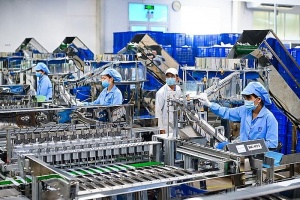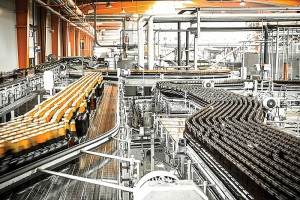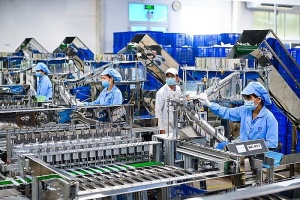Manufacturing trends to watch to help respond dynamically to the market
Manufacturers need to be able to adapt and respond to the diverse needs of data pools and wholesale distributors. This requires the development of capabilities for live data exchanges. It is essential to ensure that product content is standardised and dynamically updated.
 |
| Le Khanh Lam, Partner, RSM Vietnam |
By embracing agility, manufacturers can facilitate a seamless and efficient flow of information across a variety of platforms and partners, allowing them to focus on the competition and achieve their goals with greater ease.
The future ahead of the manufacturing industry is driven by a resolute commitment to efficiency, resilience, and responsible practices. As manufacturers navigate this dynamic landscape, integrating advanced technologies and a dedication to sustainability will play vital roles in shaping the manufacturing industry’s future. By embracing these trends and addressing challenges head-on, the manufacturing sector is poised for a new era of growth and innovation.
Manufacturers will try to prioritise post-production efficiency by 2024 through product content syndication tools. These tools will help streamline the management and distribution of product data, resulting in a seamless export of customised product content. They will also help cut costs and eliminate the need for extensive IT support, enhancing the overall manufacturing process.
Shortly, manufacturers will be engaging more directly with end-users through e-commerce and omnichannel strategies than ever before. This evolution will encompass both traditional business-to-business and direct-to-consumer approaches. This will not only diversify revenue streams but will also strengthen brand presence.
By adopting this strategy, manufacturers can gain valuable customer insights, improve the customer experience, and respond dynamically to market trends.
There are some trends to watch out for, and the first is reevaluating the supply chain. Manufacturers need to go beyond being aware of their suppliers’ and customers’ actions. They should extend their visibility to their suppliers’ suppliers and their customers’ customers.
To improve, manufacturers should invest in digital supply chain capabilities to gain better insights into each stakeholder’s functions. By doing so, each participant can make better decisions about material sourcing and customer demand.
Manufacturers can offer their products as a service, either on a fixed or usage-based price model. A subscription-based model is the definitive way to guarantee uninterrupted access to their services. Unlike traditional car leases, the automaker is responsible for registration, taxes, driver insurance, roadside assistance, and maintenance under this arrangement.
With the flexible service agreement, customers can easily switch to a new car model whenever they like. Cloud computing is also a popular product and service, where software developers deliver applications, databases, and infrastructure over the internet through a subscription.
Next, the manufacturing industry is becoming more efficient and effective thanks to the implementation of advanced technologies like digital twins, AI, machine learning, etc. These technologies allow for remote monitoring, servicing, and equipment operation without needing physical presence on-site.
Remote operation has gained significant traction in the manufacturing industry owing to the remarkable progress in communication and computing capabilities. This has enabled operators to control machines with the same precision and responsiveness as they were in the same room.
The development of so-called “dark factories,” entirely automated, is a direct result of such technology. The use of AR and VR in manufacturing is becoming more common. This trend aligns with recent manufacturing trends prioritising access, flexibility, and safety.
To build efficient operations, it is crucial to implement holistic solutions supported by a robust data and analytics foundation. Additionally, designing a lean digital core that operates on integrated, cloud-based applications can significantly improve overall efficiency. It is equally important to advocate for responsible AI frameworks to drive explainable and ethical AI use, which can contribute to high-trust, bias-free governance.
Lastly, working with industry-specific implementation partners can help with infrastructure evaluation, reporting, and end-to-end process visualisation and encourage the adoption of gen AI to identify new ways of working.
In recent years, there has been a significant increase in the focus on sustainability in manufacturing. This has been driven by a greater awareness of climate change, resource depletion, and the need for social responsibility. It is not just a fleeting trend, but a necessary response to the global challenges we face. Many companies and industries are now incorporating sustainable practices into their core operations with the aim of reducing their environmental impact and making positive contributions to society.
Manufacturers need to work together across the value chain to identify areas of their everyday operations where environmental, social, and governance (ESG) strategies can make a meaningful impact. Establishing frameworks that provide visibility into company activities, evaluate results, quantify carbon footprint, and implement ownership-based change management to support ESG initiatives and monitor progress is essential.
To create a value-driven ESG strategy, three key steps are crucial: defining the purpose and success metrics to encourage stakeholder buy-in; identifying and reducing carbon hotspots by integrating carbon data into processes; and improving fair operations by expanding decision criteria and considering the people and communities affected in the value chain.
 | Manufacturing production rises for first time in five months Manufacturers in Vietnam recorded a return to growth at the start of 2024 as tentative signs of improving demand fed through to renewed increases in new orders and output. |
 | ASEAN manufacturing sector sees slight improvement There are some new and slight improvement across the ASEAN manufacturing sector in January, according to S&P Global Ratings, with the headline ASEAN manufacturing PMI rising from 49.7 in December to 50.3. Manufacturers continued to be optimistic about the 12-month output outlook. Growth was recorded across four of the seven ASEAN members. |
 | Ho Chi Minh City: a rising hub for high-tech manufacturing Vietnam is currently one of the most attractive destinations for investors in the semiconductor sector due to advantages such as a large reserve of silica and rare earth metals (used for chip manufacturing), low labour costs, favourable geographical location, and government incentives. |
 | Manufacturing confidence jumps to one-year-high Sustained growth in new manufacturing orders has prompted a renewed increase in employment, while business confidence has jumped to a one-year-high. |
What the stars mean:
★ Poor ★ ★ Promising ★★★ Good ★★★★ Very good ★★★★★ Exceptional
Related Contents
More News
- M&A can prosper with the right steps (March 11, 2024 | 15:24)
- Preparations for a GMT overhaul (February 12, 2024 | 23:45)
- Potential is substantial for the electric vehicle industry (December 27, 2023 | 11:34)
- Implementation of the circular economy in Vietnam (November 13, 2023 | 11:30)
- Banking’s development in data and digitalisation era (November 07, 2023 | 15:24)
- ESG enabling real estate businesses to attain funds (June 16, 2023 | 15:25)
- RSM Vietnam stays ahead of the changing business environment (March 14, 2023 | 10:07)
- What might the Vietnamese economy look like in 2023? (January 02, 2023 | 21:37)
- Neobanking: a trend-setting model for the digital revolution (December 19, 2022 | 14:30)
- Evaluating the prospects of M&A upswings next year (November 28, 2022 | 08:00)

 Tag:
Tag:

















 Mobile Version
Mobile Version